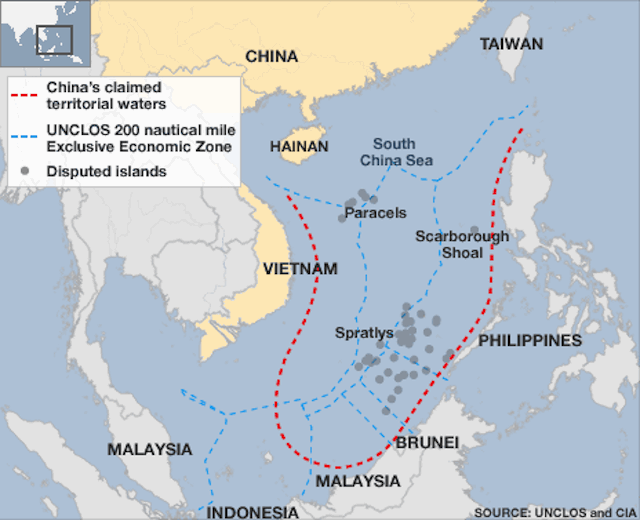China triggered an uproar when it established its “first” Air Defense Identification Zone (ADIZ) over the East China Sea in 2013, and concern is mounting that it may establish a second in the hotly-disputed South China Sea. China’s first ADIZ was contentious for three reasons. First, China did not consult with its neighbours before it announced the zone (a well-established norm). Second, China’s new ADIZ overlapped with existing Japanese, Korean, and Taiwanese zones (the East China Sea is the only region in the world where ADIZs overlap). Third, China’s zone included the Senkaku/Diaoyu Islands, administered by Japan but claimed by China, and the submerged Socotra Rock claimed by China and South Korea. The East China Sea is the only place in the world where ADIZs include contested territory.
Image: China’s territorial claims (nine dashed line) in the South China Sea and neighbouring countries’ Exclusive Economic Zones (EEZs), as well as currently disputed territory (Source: BBC News, “Q&A: South China Sea dispute”)

There is nothing in international law that prohibited China’s move. In fact, international law is completely silent on the subject of ADIZs. This lack of codification means that ADIZ governance is essentially left up to each state. As a result, practices are inconsistent. ADIZs are also badly misunderstood, at least by journalists and policy makers. China’s insistence that aircraft merely transiting its ADIZ report in advance, for example, was sharply criticized as “unusual,” when in fact it is common. Even the United States—China’s most vocal critic—requires this.
The same thing may soon happen again in the South China Sea, and if it does, it will make the first ADIZ flap look like child’s play. The South China Sea is home to some of the most dangerous maritime and territorial disputes in the world involving hundreds of small islands and half a dozen rival claimants. It is also a vital artery of the global economy. Analysts generally consider it one of the most important and most dangerous global flashpoints.
From Beijing’s point of view, the most logical demarcation of a South China Sea ADIZ would be the famous Nine-Dashed Line, which China uses to define the outer limit of its jurisdiction. The Nine-Dashed Line essentially encompasses the entire South China Sea and overlaps the territorial seas and/or Exclusive Economic Zones of Vietnam, Malaysia, Brunei and the Philippines. While China has not stated specifically exactly what rights it claims within the Nine-Dashed Line (territorial sovereignty certainly; maritime jurisdiction less certainly), if indeed Beijing understands an ADIZ as a tool for sovereignty assertion, anything less would seem inconsistent and might be interpreted domestically or internationally as a retreat. Certainly the massive land reclamation project upon which China is currently engaged will give China the capability to monitor the entire area, and potentially also to scramble interceptors rapidly. If China did seek to impose an ADIZ over the entire South China Sea, it would overlap with the Philippines’ current ADIZ, and it is a safe bet that Vietnam, Malaysia and Brunei would counter with ADIZs of their own.
A new, expansive ADIZ in the South China Sea would be detrimental to China, to regional stability, and to aviation safety around the world until and unless ADIZs in general return to their pre-2013 quietude. For more than 60 years, ADIZs were uncontroversial. They neither signaled claims to, nor conferred, maritime or territorial rights. While originally conceived and implemented as tools to promote narrow national security goals by reducing the danger of surprise attack, in practice they have generally served a public goods function by increasing transparency and predictability and by decreasing the frequency of scrambles and the risks of accident or unintended conflict attending them. Put another way, when not politicized, ADIZs perform regional security functions and enhance aviation safety. When politicized and treated as tools for sovereignty assertion, however, their benefits are lost and the risks they reduce actually increase as rival claimants deliberately fail to comply with them or aggressively challenge them.
The mysterious 2014 disappearance of Malaysia Airlines flight MH370 dramatically illustrated the potential cost of failures to coordinate, communicate, and trust, and the value of tracking and transparency. The 2001 Hainan Island EP-3 incident equally dramatically illustrated the dangers of political tugs-of-war over rights to airspace. Let us hope that all of the parties with stakes in the South China Sea see the value of avoiding a more dangerous replay of the first ADIZ crisis in 2013.


